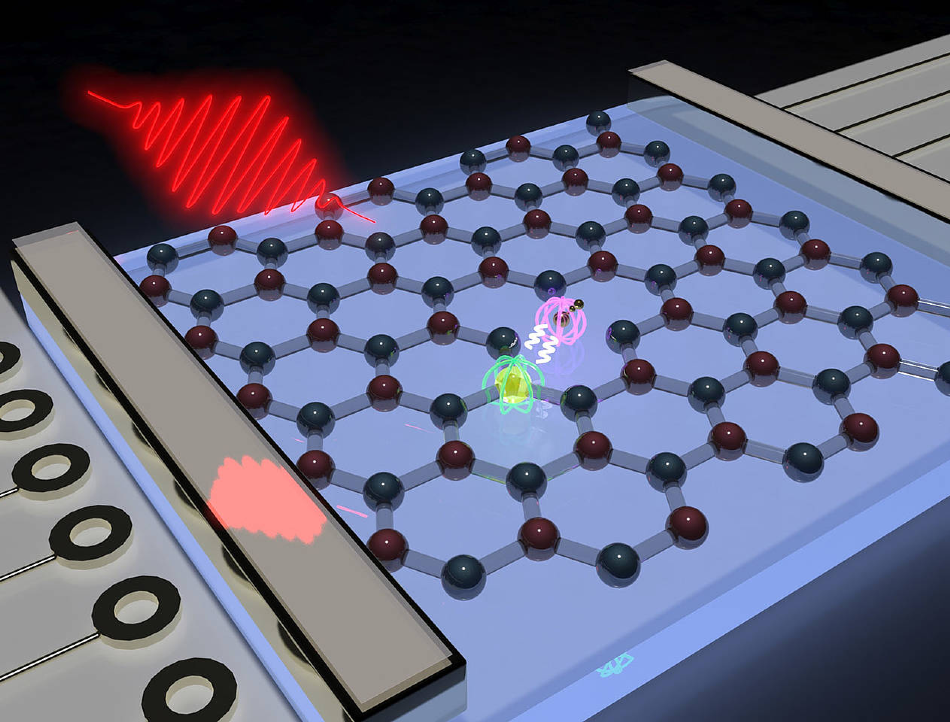Mar 3 2020
Although the structure of boron nitride is almost the same as that of graphene, it has entirely different optoelectronic properties.
 Atomic thin layer of boron nitride with a spin center formed by the boron vacancy. With the help of high-frequency excitation (red arrow), it is possible to initialize and manipulate the qubit. Image Credit: Mehran Kianinia, University of Technology Sydney.
Atomic thin layer of boron nitride with a spin center formed by the boron vacancy. With the help of high-frequency excitation (red arrow), it is possible to initialize and manipulate the qubit. Image Credit: Mehran Kianinia, University of Technology Sydney.
Boron and nitrogen elements, the constituents of boron nitride, are arranged in a honeycomb-like hexagonal structure, just like how carbon atoms are arranged in graphene. These elements arrange themselves in two-dimensional (2D) layers that have a thickness of just a single atomic layer.
However, the individual layers are weakly bound to one another by what is known as van der Waals forces. Therefore, they can be easily separated from one another.
Publication in Nature Materials
Now for the first time, physicists from Bavaria, at the Germany-based Julius-Maximilians-Universität Würzburg (JMU), in association with the Technical University of Sydney in Australia, have experimentally demonstrated the so-called spin centers present in a boron nitride crystal.
These important experiments were handled and performed by Professor Vladimir Dyakonov, the Chair of Experimental Physics VI at the Institute of Physics, as well as his group from the JMU side. The study results have been published in the scientific journal Nature Materials.
The physicists identified a unique defect in the layered crystal lattice of boron nitride, that is, a missing boron atom, which displays a magnetic dipole moment, also called spin. In addition, this boron atom can release and absorb light and is also referred to as the color center.
To fully analyze the magneto-optical characteristics of the quantum emitter, the JMU team has devised a unique experimental method in which a combination of a static and high-frequency magnetic field is used.
A Little Luck is Needed
If you vary the frequency of the alternating magnetic field, at some point you hit exactly the frequency of the spin, and the photoluminescence changes dramatically.
Vladimir Dyakonov, Professor and Chair of Experimental Physics VI, Institute of Physics, University of Würzburg
As it is not easy to estimate the range of frequencies that one has to look for unidentified spin states, a bit of luck is also required. Along with his team, Dyakonov had successfully identified these spin centers in the 2D crystalline system, which earlier had only been predicted at the theoretical level.
Among various other things, the researchers successfully showed spin polarization, that is, the alignment of the magnetic moment of the defect under optical excitation. This occurs even at room temperature.
This also renders the experiments fascinating for technical applications: Globally, researchers are presently looking for ways to identify a solid-state system, where the spin state can be manipulated when required, aligned, and subsequently read-out electrically or optically.
The spin center we have identified in boron nitride meets these requirements.
Vladimir Dyakonov, Professor and Chair of Experimental Physics VI, Institute of Physics, University of Würzburg
Because it has a spin and further releases and absorbs light, it is a quantum bit that can be utilized in quantum information and quantum sensing. The latest navigation technology is also expected to work with this technology, and this is the reason why space agencies like NASA and DLR are doing intensive studies on this topic, as well.
Material Design by the Lego Brick Principle
Even for basic researchers, the 2D materials are fascinating from another standpoint. These materials have a highly unique layer structure, which together with the only weak coupling of the layers to each other, provides the possibility of designing varied stacking sequences from various semiconductors.
If you then place a defect in one of these layers, we call it a spin probe, this can help to understand the properties of the adjacent layers, but also to change the physical properties of the entire stack.
Vladimir Dyakonov, Professor and Chair of Experimental Physics VI, Institute of Physics, University of Würzburg
Subsequently, Dyakonov and his collaborators are planning to develop heterostructures, among other things. Heterostructures are composed of multilayer semiconductors, featuring a boron nitride layer that serves as an intermediate layer.
The researchers are convinced so: “If the atomically thin layers of boron nitride, which are ‘decorated’ with individual spin centers, can be produced and incorporated into a heterostructure, it will be possible to design artificial two-dimensional crystals based on Lego brick principles and investigate their properties.”
Funding
The study was financed by a number of funding agencies, including the Alexander von Humboldt Foundation and the German Research Foundation (DFG). It is closely associated with the Cluster of Excellence ct.qmat (Würzburg-Dresden), where Vladimir Dyakonov serves as a Principle Investigator.